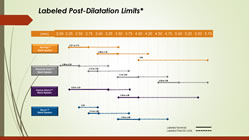For the interventionalist, proper sizing of coronary stents is critical. While imaging via angiography has been the standard for years, newer intravascular imaging technologies, such as IVUS and OCT, are becoming more widely used, as evidence accrues that these modalities make a difference in outcomes. For example, IVUS (Intravascular Ultrasound) not only allows the measurement of the exact open diameter of the vessel, as seen on angiography, but it shows the “invisible to angiography” layer of plaque. plaque that will be compressed, so that a more accurate post-PCI diameter can be determined. Under-expanded stents have been associated with increased stent thrombosis and restenosis. Continue reading
Category Archives: Imaging
Post-Dilatation Stent Sizes
Filed under Angiograms, Drug-Eluting Stents, Imaging, IVUS, OCT, Stent, Stent Thrombosis
AimRADIAL Masterclass V + FFR Workshop in Budapest
 On September 22-23, 2016, the 5th Advanced International Masterclass on the Transradial Approach will be held in Budapest, Hungary. And this year, AimRADIAL will be preceded on September 21 by a one-day comprehensive workshop covering all aspects of Fractional Flow Reserve (FFR) from the basic principles and set-up in the cath lab, to the differences between FFR, iFR, and CFR, a comprehensive review of the clinical study data so far, and finally a look at future modalities, like FFR-CT (although the title of that talk by Dr. Nick Curzen is “FFR-CT: the future is now“). Continue reading
On September 22-23, 2016, the 5th Advanced International Masterclass on the Transradial Approach will be held in Budapest, Hungary. And this year, AimRADIAL will be preceded on September 21 by a one-day comprehensive workshop covering all aspects of Fractional Flow Reserve (FFR) from the basic principles and set-up in the cath lab, to the differences between FFR, iFR, and CFR, a comprehensive review of the clinical study data so far, and finally a look at future modalities, like FFR-CT (although the title of that talk by Dr. Nick Curzen is “FFR-CT: the future is now“). Continue reading
Happy 100th Anniversary to the RSNA
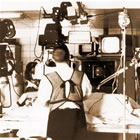
Mason Sones in a Philips cath lab of the 50’s
This week the Radiological Society of North America, a.k.a. RSNA, is holding its annual meeting in Chicago. RSNA is an international society of radiologists, medical physicists and other medical professionals with more than 54,000 members from 136 countries across the globe. And this year the 55,000 attendees in Chicago are celebrating something special: the 100th anniversary of the RSNA.
To help honor the work of the Society, Angioplasty.Org would like to offer the video below which details the impact that imaging had on our field: the treatment of coronary artery disease. Continue reading
Filed under ACC, Angiograms, History, Imaging, Innovators, Meetings & Conferences, Video
iFR and iFR Scout to be Featured in Live Case from Hammersmith
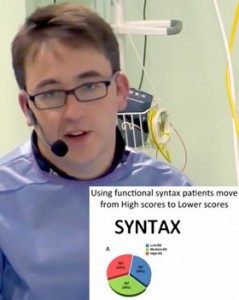
Dr. Justin Davies discusses value of using physiology-guided PCI
If you’ve been wondering what iFR (Instant wave-Free Ratio) is, how it works, how it compares to FFR (Fractional Flow Reserve) and, most importantly, how it affects clinical outcomes, then click here to register for a free, online, interactive live case being done on Monday, April 13, 2:30pm-3:30pm London Time, 9:30am-10:30am New York Time).
Interactive: that means you can ask questions!
Dr. Justin E Davies, interventional cardiologist at Imperial College NHS Trust, and developer of iFR, will be performing and guiding the worldwide audience through a live complex PCI multivessel case, using physiology to guide his procedure. Continue reading
Consumer Reports Overstates Cardiac CT Radiation Dose
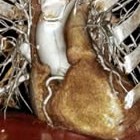 Consumer Reports regularly publishes health information to aid the consumer/patient in making decisions. And that’s a good thing. But also important is having the most current information, which their January 27, 2015 article, titled “The surprising dangers of CT scans and X-rays,” does not.
Consumer Reports regularly publishes health information to aid the consumer/patient in making decisions. And that’s a good thing. But also important is having the most current information, which their January 27, 2015 article, titled “The surprising dangers of CT scans and X-rays,” does not.
All of the cautions about imaging tests that are listed in the Consumer Reports article are valid: ask why the test is necessary; check the credentials of the imaging specialist; ask for the lowest effective dose; avoid unnecessary repeat scans.
But one important piece of data is almost a decade old and, as a result, is potentially misleading. I’m talking about the radiation dose from a Cardiac CT scan. The article states that a Cardiac CT Angiogram (CTA) exposes the patient to 12 mSv of ionizing radiation, or 120 times that of a chest X-ray. This was true years ago, when CTA was first being used to diagnose coronary artery disease. But it is not true today. Continue reading
Filed under Cardiac CT, Imaging, Media Coverage, Non-Invasive Testing
Philips Buys Volcano: It’s About Money, Technology, and History
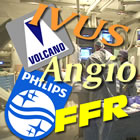 Rumors and theories about an acquisition of Volcano Corporation (NASDAQ: VOLC) had been circulating for quite some time: months, years even. The company seemed an obvious choice: it has an advanced intravascular ultrasound (IVUS) technology that leads the market, with Boston Scientific coming in second; it has a fractional flow reserve (FFR) wire that splits the market with St. Jude Medical; and recently Volcano gained FDA approval for its Instant Wave-Free Ratio (iFR) physiologic measurement product, a faster, cheaper potential alternative to FFR. Continue reading
Rumors and theories about an acquisition of Volcano Corporation (NASDAQ: VOLC) had been circulating for quite some time: months, years even. The company seemed an obvious choice: it has an advanced intravascular ultrasound (IVUS) technology that leads the market, with Boston Scientific coming in second; it has a fractional flow reserve (FFR) wire that splits the market with St. Jude Medical; and recently Volcano gained FDA approval for its Instant Wave-Free Ratio (iFR) physiologic measurement product, a faster, cheaper potential alternative to FFR. Continue reading
FFR and iFR: Roadmapping Your Heart, “With Traffic”
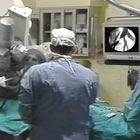 The coronary angiogram is often referred to as a road map of the heart. As such, it serves the cardiologist and cardiac surgeon well. It shows where the coronary arteries are, how they intersect, the angles of the branches, etc. There are diagrams of these anatomical features in many textbooks, but the reality is that these characteristics can vary from individual to individual, so it’s necessary to get a road map for each individual in whom an intervention is being contemplated. Then, of course, there’s the issue of narrowings in the coronary arteries. Should these receive stents? Should they be bypassed? Should they be left alone and treated with medical therapy? Continue reading
The coronary angiogram is often referred to as a road map of the heart. As such, it serves the cardiologist and cardiac surgeon well. It shows where the coronary arteries are, how they intersect, the angles of the branches, etc. There are diagrams of these anatomical features in many textbooks, but the reality is that these characteristics can vary from individual to individual, so it’s necessary to get a road map for each individual in whom an intervention is being contemplated. Then, of course, there’s the issue of narrowings in the coronary arteries. Should these receive stents? Should they be bypassed? Should they be left alone and treated with medical therapy? Continue reading
Filed under Angiograms, FAME I / FAME II, FFR, Heart Attack, Imaging, Stent

